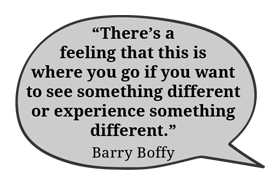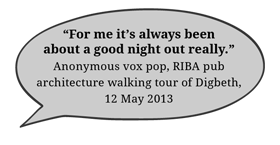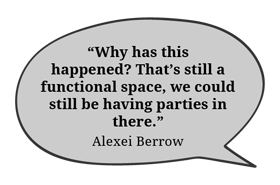Our interviewees emphatically point to how Digbeth differs from the rest of Birmingham and stress its importance as an alternative to mainstream culture. Anna Young, who has spent time in the area regularly since 2001, describes Digbeth as industrial but also freer and more vibrant than the rest of Birmingham.
 The Custard Factory provides a daytime hub of vintage shops and events attended by visitors and residents. Barry Boffy, a Digbeth resident since 2011, tells us that he often visits on a Saturday as there is always something interesting happening, whether it is a vintage bazaar or a pop-up shop. He says that The Custard Factory has really acknowledged that there is an appetite for something other than the high street and the area has “a real buzz”. Peter Smyth and Emma Case agree with this. Although they work in the area, they also make the effort to attend events in Digbeth at the weekend as they feel it is a thriving and exciting place to be. Indeed, Sara Preisler says that Digbeth has a quiet energy that builds to a crescendo at the weekends.
The Custard Factory provides a daytime hub of vintage shops and events attended by visitors and residents. Barry Boffy, a Digbeth resident since 2011, tells us that he often visits on a Saturday as there is always something interesting happening, whether it is a vintage bazaar or a pop-up shop. He says that The Custard Factory has really acknowledged that there is an appetite for something other than the high street and the area has “a real buzz”. Peter Smyth and Emma Case agree with this. Although they work in the area, they also make the effort to attend events in Digbeth at the weekend as they feel it is a thriving and exciting place to be. Indeed, Sara Preisler says that Digbeth has a quiet energy that builds to a crescendo at the weekends.
Arts events and organisations are also an important draw for visitors. Antonio Roberts mentions that on a typical day he might visit the galleries on Heath Mill Lane and then return in the evening for an exhibition opening. Anna Young says that she had been going to more arts-based events since 2006, such as Eastside Projects, VIVID, and Flatpack Festival. Alicja Kaczmarek is also enthusiastic about Digbeth’s arts events and exhibition openings and was going to a Stryx exhibition in Minerva Works straight after her interview for this project.
 Many of our interviewees discuss Digbeth’s nightlife and, in some cases, have more to say about this than the area’s daytime activities. Peter Smyth says that there is “always stuff going on, whether you’re into indie music or dance music, there’s something for everyone.”
Many of our interviewees discuss Digbeth’s nightlife and, in some cases, have more to say about this than the area’s daytime activities. Peter Smyth says that there is “always stuff going on, whether you’re into indie music or dance music, there’s something for everyone.”
Alexei Berrow recalls going to gigs and club nights around 2001-2004, particularly the Tokyo Lucky Hole night at the Market Tavern, which was a Japanese-themed indie night with bands and projections of Japanese films. He emphasises that there was nothing else like it in Birmingham, adding “to me [the organisers] are Digbeth” because of their dedication to creating a great night.
There is also a recurring sense that in Digbeth everywhere looks the same and it is possible to end up in unexpected places, without seeming to know where you are going. For example, Anna Young recalls going to a Halloween film night next to a tool shop, but added that she has never been to that road again since. Antonio Roberts recounts that one night he went with friends to a place under the railway arches that he had always thought was an abandoned warehouse, but it turned out to be an RnB club.
There is a strong crossover between nights out and the arts scene. Antonio discusses events at VIVID which he describes as “experimental multimedia video performance”. He recalls one such event where music was generated by fluorescent tubes and another where a man was painting on a wall with a dead bird. Meanwhile, one of the more recent events that Anna Young attended was Fierce Festival’s Holy Mountain party in 2012, which was held in what is now a reggae club and involved painting with body parts.
Our participants express a feeling that Digbeth is always in a state of change, which they see as both a positive and negative part of its character.
 Alexei Berrow and Anna Young both discuss the history of conflict between residents and pubs and music venues; both The Rainbow and The Spotted Dog have been threatened by noise complaints from residents. Alexei further argues that the constant threat of places being closed for redevelopment means that business owners often feel that they cannot plan for the future. He describes his frustration at how a venue would often close but then he would walk past two years later to find that the building was still there and unused. For example, The Old Wharf, a metal and punk pub, closed down a couple of years ago but the building remains boarded up.
Alexei Berrow and Anna Young both discuss the history of conflict between residents and pubs and music venues; both The Rainbow and The Spotted Dog have been threatened by noise complaints from residents. Alexei further argues that the constant threat of places being closed for redevelopment means that business owners often feel that they cannot plan for the future. He describes his frustration at how a venue would often close but then he would walk past two years later to find that the building was still there and unused. For example, The Old Wharf, a metal and punk pub, closed down a couple of years ago but the building remains boarded up.
However, our interviewees also attribute some of Digbeth’s excitement to this sense of transience. Alexei and Anna both discuss the “buzz” of events in anonymous warehouses where they would ascend a winding rickety staircase to find an empty space transformed. Things change regularly in The Custard Factory too; Barry Boffy reveals that he keeps going back because there will always be something new and unique. The view that is consistently conveyed in the interviews is that this lack of stability, although sometimes troubling, feeds into Digbeth’s unique atmosphere.